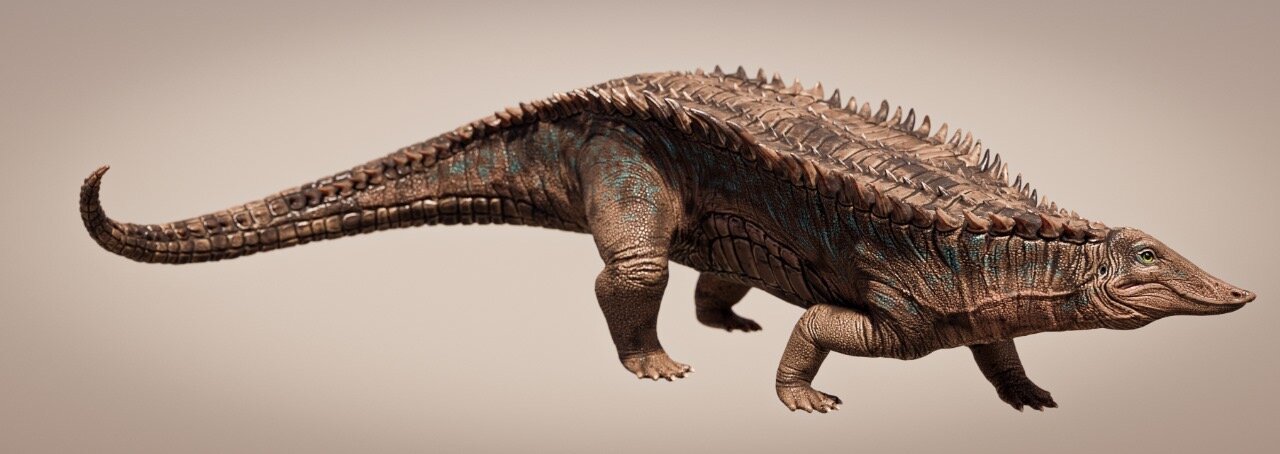Move over dinosaurs, there's a new prehistoric top dog in town! A new study reveals a heavily armored cousin of modern crocodiles that ruled the world before the reign of the dinosaurs.
These "tanks of the Triassic," known as aetosaurs, lived about 200 million years ago and came in various shapes and sizes. Their fossils have been found everywhere except Antarctica and Australia. Scientists typically identify different aetosaur species by examining the bony plates that made up their armor, since complete skeletons are rare.
However, a recent breakthrough has come from researchers at The University of Texas at Austin. They've been studying an exceptionally well-preserved aetosaur suit of armor, nearly 70% complete and covering most of the body. This armor, called a carapace, is detailed in a new paper published in The Anatomical Record.
"We basically have everything from the back of the neck and shoulder area all the way to the tip of the tail," said William Reyes, a doctoral student at UT Jackson School of Geosciences and lead author of the study. "Usually, finding such a complete specimen is very uncommon."
Using this remarkable armor, Reyes and his team were able to identify a new aetosaur species. They named it Garzapelta muelleri. "Garza" is a nod to Garza County in Texas, where the fossil was found, and "pelta" is Latin for shield, referencing the creature's heavily armored body. The species name "muelleri" honors the paleontologist who first discovered the fossil, Bill Mueller.
Imagine a modern crocodile, but decked out in armadillo armor – that's what Garzapelta would have looked like. These bony plates, called osteoderms, were embedded in the animal's skin, forming a protective mosaic-like shell. In addition to body armor, Garzapelta also sported spikes along its sides for extra defense. While modern crocodiles are carnivores, scientists believe aetosaurs were mostly omnivores.
Interestingly, the spikes on Garzapelta closely resemble those found on another aetosaur species, even though the two creatures are not closely related. This is an example of convergent evolution, where similar traits develop independently in different species. The evolution of flight in insects, birds, mammals, and pterosaurs is another classic example of this phenomenon.
According to Reyes, Garzapelta's unique features on its plates, including how they fit together and the presence of specific bumps and ridges, clearly classify it as a new species. However, determining its place in the aetosaur family tree proved challenging. Depending on which part of the armor researchers focused on, Garzapelta ended up in very different spots. For instance, the back armor resembled one species, while the midsection spikes resembled another.
By recognizing that the spikes evolved independently, the researchers were finally able to place Garzapelta accurately among other aetosaurs. This study highlights how convergent evolution can introduce complexities in paleontological analyses.
"Convergence of osteoderms across distantly related aetosaurs has been observed before, but Garzapelta muelleri's carapace is the best example we have," said Reyes. "It showcases the extent to which convergence can occur and the problems it can cause in our evolutionary studies."
The Garzapelta fossil belongs to the Texas Tech University collections. It sat unnoticed on a shelf for nearly 30 years before Reyes came across it during a visit. Bill Parker, an aetosaur expert at Petrified Forest National Park who was not involved in the study, emphasizes the crucial role of university and museum collections in enabling such research.
"These specimens weren't just unearthed yesterday," he said. "They've been in museums for decades, waiting for someone like Will to come along and bring them to life through research."
Reyes's work doesn't stop here. He's now investigating how factors like age and sex might influence armor appearance in aetosaurs. He's using fossils from the Jackson School's collection, most of which were unearthed during WPA excavations in the 1940s.




0 Comments